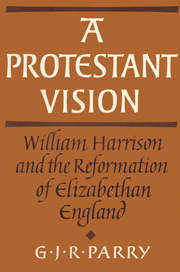4 - A reformed church
Published online by Cambridge University Press: 20 October 2009
Summary
We have already seen that other prominent members of the Elizabethan Church shared Harrison's outlook on the world, and now we must examine the wider implications of this way of thinking. Harrison believed that the covenant line had transmitted through its historical experiences, both in the Scriptures and afterwards, the doctrinal criteria by which he could assess all human knowledge. The previous chapters examined his application of those Scriptural criteria to the arcana of prophecy, chronology and historical interpretation, and in passing pointed out the intimate relationship between his thinking on those matters and his notions about the nature and role of the Church, its relationship to the worldly powers, and the proper objectives of human society and human intellect. Now we can investigate Harrison's application of those same Scriptural criteria to these human institutions, and particularly the Elizabethan Church, while subsequent chapters will follow the same course through Harrison's thinking about political power, social organisation, and the investigation of Nature.
In this chapter we move away from the European sources of Harrison's developing ideas and relate his outlook more specifically to the experiences of Englishmen under Elizabeth. Here the ‘Chronology’ offers an unusually detailed insight into the historical assumptions behind Harrison's reforming ideas. For we can categorise Harrison's thoughts about the Elizabethan Church, and his activities within its institutional structure, as those of a moderate Puritan, in the descriptive sense in which modern historians use that term. Yet we can only fully understand those ideas and actions in the light of the historical interpretation of the Two Churches which simultaneously reflected and conditioned Harrison's interpretation of his contemporary world.
- Type
- Chapter
- Information
- A Protestant VisionWilliam Harrison and the Reformation of Elizabethan England, pp. 141 - 198Publisher: Cambridge University PressPrint publication year: 1987

